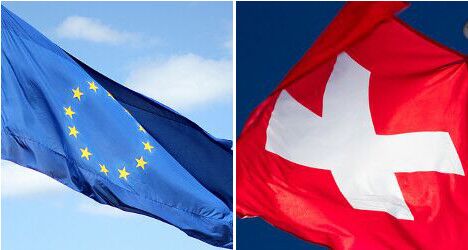Why does Switzerland want to curb immigration from EU countries?
Back in February 9th 2014 Switzerland held a crucial referendum. Championed by the anti-immigration Swiss People’s Party (SVP), the so-called 'against mass immigration' initiative called for some form of quotas to be placed on immigration from the EU (there are already limits on immigration from outside the EU).
Much to many people’s surprise – and against the government’s advice – the Swiss people narrowly voted in favour of the popular initiative. As the referendum was legally binding, the initiative had to be implemented, and the Swiss government had three years from then on to figure out exactly how.
What’s the problem?
Attempting to curb EU immigration is like opening Pandora’s box.
Though not a member of the EU, Switzerland has hundreds of bilateral agreements with the bloc, its main trading partner, that aim to facilitate trade and collaboration. One of those bilaterals is the free movement of people, one of the EU’s founding principles.
Any curbs on EU immigration would contravene the free movement agreement between Switzerland and the EU.
After the Swiss people voted ‘yes’ to the popular initiative the Swiss federal government said it could not lawfully sign an EU protocol on extending the free movement of people to new EU member Croatia, which was already in the pipeline.
This first transgression against the EU’s free movement principle caused the European Commission to react in anger. If Switzerland blocked free movement then the EU would rip up other agreements between the two, it said.
As an immediate consequence, Swiss students were prevented from taking part in Europe’s Erasmus student exchange programme, and the future of Swiss scientists’ participation in important Europe-wide research programmes, such as Horizon 2020, was left in serious doubt.
All this was a very clear demonstration by the EU that Switzerland can’t cherry-pick its bilateral agreements. Perhaps down the line there may have been some wiggle room for Switzerland, however Britain’s Brexit referendum then threw another spanner in the works. Since then the EU has become even more loath to give Switzerland any concessions it could then be forced to give to Britain, too.
So what’s the answer?
That’s what the Swiss government has spent more than two years trying to figure out. And it hasn’t yet arrived at a definitive conclusion – but it’s getting there.
In September the National Council – the lower house of parliament – rather controversially took the decision not to impose strict quotas on EU immigration unilaterally.
Instead it favoured a ‘light’ implementation of the 2014 initiative which would see Swiss nationals prioritized for jobs if immigration went above a certain threshold in that particular job sector. More drastic measures would only be taken if Brussels agreed.
This supposedly ‘EU-compatible’ way forward was passed only after fierce debate and was attacked by some, including the SVP, which had backed the ‘against mass immigration’ initiative. They said the ‘light’ solution veered too far from the text of the initiative. To ignore the will of the people would signal the “death of direct democracy”, said one SVP MP.
However the majority of MPs felt it was more important to maintain the country's relationship with the EU than apply the 2014 initiative to the letter.
Since then, the two houses of parliament have been batting this ‘light’ solution back and forth as they try to pin down a detailed plan they can both agree on.
The devil’s in the detail…
Last week the Council of States – the upper house – said in job sectors and regions affected by higher than average unemployment, companies should have to report vacancies to unemployment offices and be obliged to invite Swiss candidates for interview. If Swiss applicants are subsequently turned down in favour of foreign applicants, the companies must justify why.
Slammed by some, including the president of workers union SGV, Jean-François Rime, as a “bureaucratic monster”, that idea was partially dismissed by the lower house on Monday, which said companies should not be obliged to justify the refusal of a Swiss candidate.
And so the issue goes back to the upper house for further debate…
What do the Swiss people think of all this?
Opinions fluctuate. Whilst one survey conducted back in late 2014 found that most people were ready for Switzerland to sacrifice its bilateral agreements with the EU in favour of imposing strict immigration quotas, other polls have differed.
In May this year a rather contradictory survey suggested the Swiss people want to have their cake and eat it too: although 53 percent wanted to introduce restrictions on free movement, if forced to choose, 54 percent would opt to maintain bilateral agreements with the EU even if that meant disregarding the 2014 referendum.
In other words, they’re as mixed up about it as the government is.
However there is also a well of support for another popular initiative called RASA – meaning ‘break the deadlock’ – which is calling, effectively, for a second referendum on the issue.
Feeling that the 2014 referendum had “unpredictable and unacceptable consequences,” RASA suggests the people have the right to think again, now those consequences are clearer.
Its main aim is to preserve bilateral treaties with the European Union, including the free movement of people.
“We're not saying that they got it wrong. But that the consequences of the vote are bad and it's worth considering the question a second time,” said RASA backer Andreas Auer earlier this year.
The Swiss government is against RASA, agreeing that maintaining EU bilaterals is “essential” but saying it is opposed to the idea of going back on a results of a popular vote after such a short space of time.
What happens next?
Parliament has until December 16th to come up with a proposal both houses can agree on.
But even they deem their solution EU-compatible, it remains to be seen if Brussels will concur.
Officially the EU will not make any concessions whatsoever regarding free movement, but unofficially the Commission could accept an ‘imperfect’ solution from Switzerland, a source told Le Temps in November.
However, wrote the paper on Sunday, there remain worries in Brussels that Switzerland’s ‘light’ solution could lead to the discrimination of EU nationals in the Swiss labour market.
Speaking to Le Temps, the spokesperson for EU Commission President Jean-Claude Juncker refused to comment on the Swiss parliament’s current line of thinking, saying only “there can’t be discrimination between Swiss and Europeans”.
Some fear that the Commission could be pressured by Switzerland’s neighbours, France, Germany and Italy, into not accepting Switzerland’s job-orientated solution. All three countries have a significant number of cross-border workers holding jobs in Switzerland, and would oppose any attempts to hinder their access to the Swiss labour market.
If the EU deems the ‘light’ solution to be compatible with free movement, Juncker and Swiss President Johann Schneider-Ammann will announce the bilateral deal in Brussels hopefully by the end of December.
Switzerland will then be able to sign the protocol extending free movement to Croatians, Swiss scientists will no longer be threatened with exclusion from EU programme Horizon 2020 and many people – except, perhaps, the SVP – will surely breathe a huge sigh of relief.
And if not?
Then Switzerland could be forced to impose its solution unilaterally, since it is bound by law to implement the 2014 initiative by February 2017. That could mean serious consequences for its relationship with Europe. And the issue will rumble on… and on…and on.



 Please whitelist us to continue reading.
Please whitelist us to continue reading.
Member comments